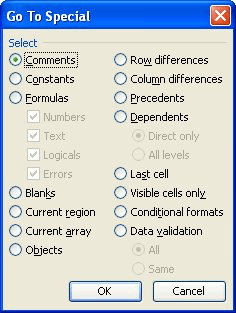Please Note: This article is written for users of the following Microsoft Excel versions: 97, 2000, 2002, and 2003. If you are using a later version (Excel 2007 or later), this tip may not work for you. For a version of this tip written specifically for later versions of Excel, click here: Selecting Formulas.
Written by Allen Wyatt (last updated November 15, 2025)
This tip applies to Excel 97, 2000, 2002, and 2003
Excel allows you to quickly select all the formulas in a worksheet. You may want to do this in preparation for applying formatting, or for some other purpose. To select all your formulas, follow these steps:

Figure 1. The Go To Special dialog box.
ExcelTips is your source for cost-effective Microsoft Excel training. This tip (2741) applies to Microsoft Excel 97, 2000, 2002, and 2003. You can find a version of this tip for the ribbon interface of Excel (Excel 2007 and later) here: Selecting Formulas.

Create Custom Apps with VBA! Discover how to extend the capabilities of Office 365 applications with VBA programming. Written in clear terms and understandable language, the book includes systematic tutorials and contains both intermediate and advanced content for experienced VB developers. Designed to be comprehensive, the book addresses not just one Office application, but the entire Office suite. Check out Mastering VBA for Microsoft Office 365 today!
Tired of the Find and Replace dialog box blocking the view of your worksheet when you are searching for information? Do ...
Discover MoreExcel has a great (and little known) shortcut for filling a column with information. It comes in very handy when you need ...
Discover MoreIf you copy a cell that contains a reference to external data, do you get an error? It could be due to the complexity of ...
Discover MoreFREE SERVICE: Get tips like this every week in ExcelTips, a free productivity newsletter. Enter your address and click "Subscribe."
There are currently no comments for this tip. (Be the first to leave your comment—just use the simple form above!)
Got a version of Excel that uses the menu interface (Excel 97, Excel 2000, Excel 2002, or Excel 2003)? This site is for you! If you use a later version of Excel, visit our ExcelTips site focusing on the ribbon interface.
FREE SERVICE: Get tips like this every week in ExcelTips, a free productivity newsletter. Enter your address and click "Subscribe."
Copyright © 2026 Sharon Parq Associates, Inc.
Comments